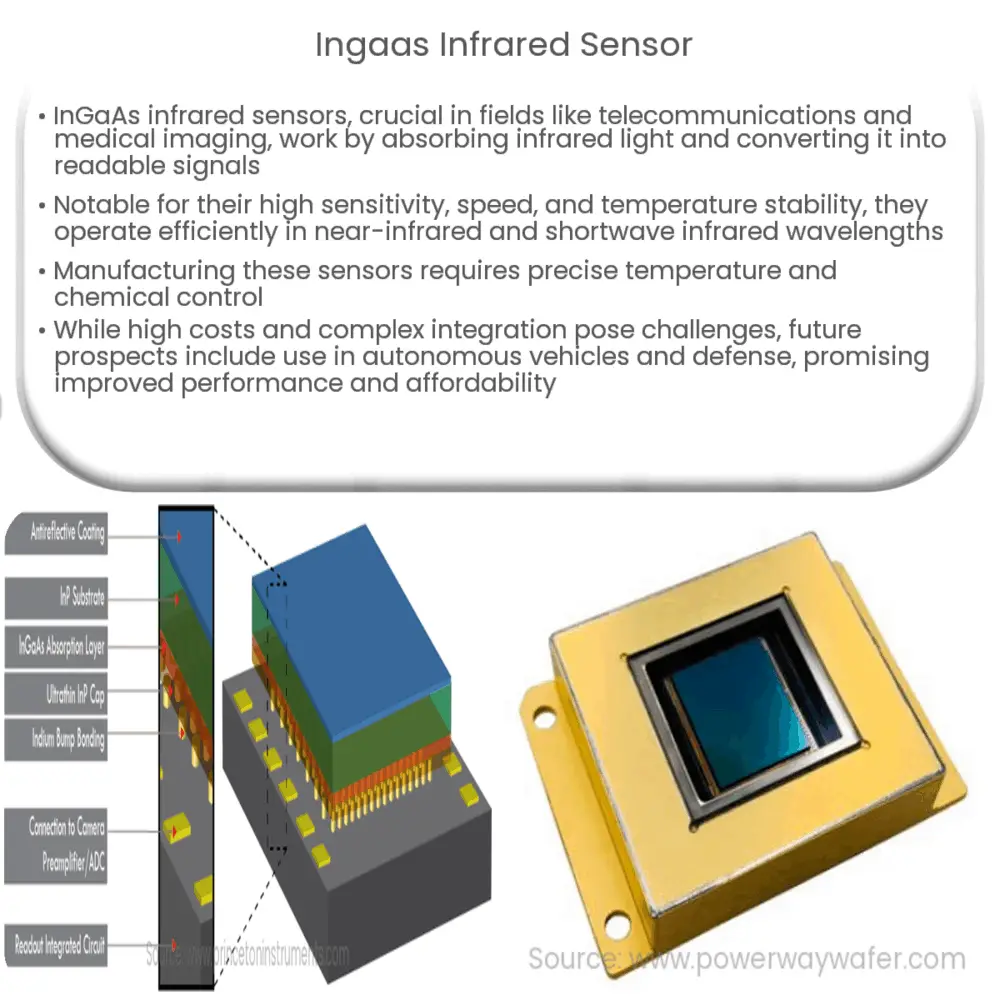Explore the world of InGaAs infrared sensors, their unique features, manufacturing process, applications, and future prospects.

Understanding InGaAs Infrared Sensors
Infrared sensors are fundamental components in numerous applications, ranging from medical equipment to telecommunications. One of the most significant types of infrared sensors is the Indium Gallium Arsenide (InGaAs) sensor. In this article, we will delve deeper into the understanding of InGaAs infrared sensors, their unique features, and their applications.
What are InGaAs Infrared Sensors?
InGaAs infrared sensors are a type of photodetector that operate in the infrared wavelength range. They are composed of a semiconductor material known as Indium Gallium Arsenide (InGaAs). These sensors work by absorbing infrared light, which induces an electric current in the sensor. This current is then processed and converted into a readable signal, providing valuable information about the environment or the object being observed.
Unique Characteristics of InGaAs Infrared Sensors
- Wavelength Range: InGaAs sensors operate efficiently in the near-infrared (NIR) and shortwave infrared (SWIR) wavelengths, typically from 0.9 to 2.6 micrometers. This range is particularly useful for many applications, including telecommunications and spectroscopy, that require high-sensitivity detection.
- High Sensitivity and Speed: InGaAs sensors are known for their high sensitivity and speed. These sensors can detect even minute changes in infrared light, enabling precise measurements. Furthermore, they can process these changes quickly, providing real-time data and insights.
- Temperature Stability: Unlike other types of infrared sensors, InGaAs sensors maintain a high level of performance across a wide temperature range. This makes them suitable for use in harsh environments where temperatures may fluctuate.
Applications of InGaAs Infrared Sensors
- Telecommunications: In telecommunications, InGaAs sensors are used in fiber optic communication systems. They can detect the infrared light transmitted through fiber optic cables, providing fast, accurate data transmission.
- Medical Imaging: In medical imaging, InGaAs sensors contribute to creating high-resolution images, particularly in optical coherence tomography (OCT). This non-invasive imaging test uses light waves to capture micrometer-resolution images from within optical scattering media (e.g., biological tissue).
These are just a few examples of how InGaAs infrared sensors are shaping our world. In the next section, we will explore more about the manufacturing process of these sensors, their ongoing developments, and future prospects.
Manufacturing and Developments of InGaAs Infrared Sensors
Manufacturing InGaAs infrared sensors involves a complex process, primarily the epitaxial growth of thin layers of InGaAs on a substrate. This method requires precise control over the temperature and chemical composition to ensure high-quality, efficient sensors.
Recent developments in InGaAs sensor technology focus on improving the sensitivity and range of these devices. Researchers are exploring methods to enhance the efficiency of these sensors at longer infrared wavelengths, making them even more versatile for a wider range of applications.
Future Prospects of InGaAs Infrared Sensors
The future of InGaAs infrared sensors looks promising, with potential growth in various industries. In autonomous vehicles, for instance, these sensors could provide essential data for obstacle detection and navigation, particularly in low-light conditions. Moreover, in the defense and security sector, they could assist in advanced surveillance systems, offering better image resolution and detection capabilities.
Challenges and Opportunities
- Cost: One of the main challenges in the widespread adoption of InGaAs sensors is their cost, which is higher than that of other types of infrared sensors. However, ongoing research and developments could potentially reduce manufacturing costs in the future.
- Integration: Integrating InGaAs sensors into existing systems can be complex. But, with the advancement in semiconductor technology, seamless integration of these sensors in various devices and systems is expected to improve.
Conclusion
In conclusion, InGaAs infrared sensors are an important tool in a wide variety of applications due to their unique ability to detect infrared light in the near-infrared and shortwave infrared wavelengths. Despite the challenges in cost and integration, the future of these sensors is promising, given their potential in areas like telecommunications, medical imaging, autonomous vehicles, and defense. As technology progresses, we can expect further enhancements in the performance, affordability, and versatility of InGaAs infrared sensors, making them even more integral in our technologically-driven world.

